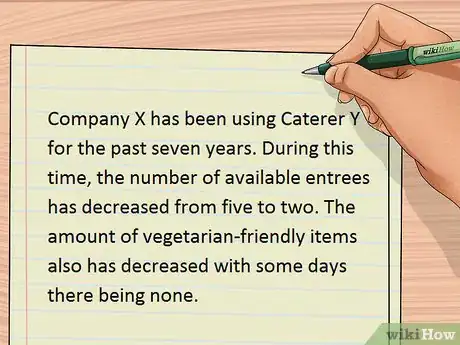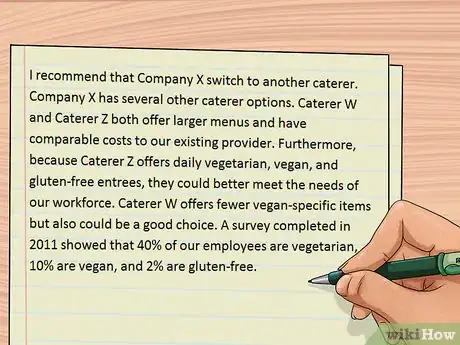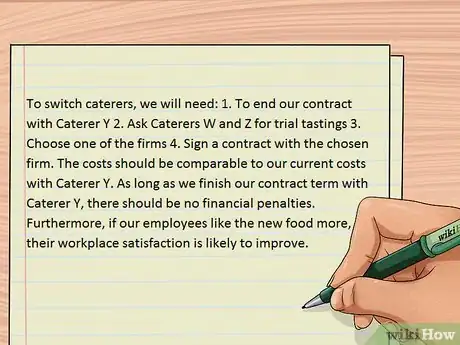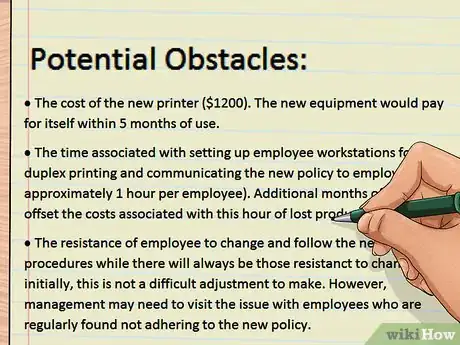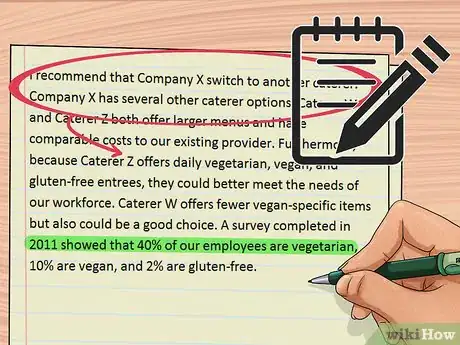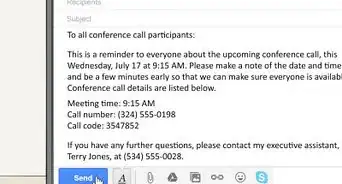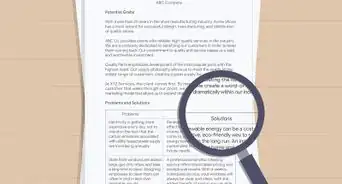wikiHow is a “wiki,” similar to Wikipedia, which means that many of our articles are co-written by multiple authors. To create this article, 13 people, some anonymous, worked to edit and improve it over time.
wikiHow marks an article as reader-approved once it receives enough positive feedback. In this case, several readers have written to tell us that this article was helpful to them, earning it our reader-approved status.
This article has been viewed 696,000 times.
Learn more...
Writing to management is useful if you want to propose procedural improvements, additional income possibilities, or ways to be more economical. You also might write a proposal if you notice something that you feel must change. If you want to write a proposal to the management of your company, take the time to gather needed information. Run your ideas by your co-workers to see if they agree. Approach management tactfully.
Steps
Sample Proposals
Crafting Your Proposal
-
1Determine your idea or problem. Whether you want to write about streamlining operations or reducing costs, figure out what the key issue is. Often, the idea might be clear to you. If, however, you are trying to make a mark or troubleshoot, be observant.[1]
-
2Do your research. Before writing a proposal, be sure to check all the facts. Talk to relevant people whether co-workers, managers, or customers. Read about similar companies and see what they do differently.
- For example, if you think the management should change its caterer, talk first to the kitchen staff. What do they think? Have they worked in other places with different caterers? What do your co-workers think? Maybe your disgruntlement is a matter of personal taste rather than quality.
Advertisement -
3Write a problem description. To start your proposal, describe what is happening at present. Include all relevant facts (who is involved, dates, locations). In this part, do not issue judgement; rather, just explain things as they are.[2]
- For example, you might write “Company X has been using Caterer Y for the past seven years. During this time, the number of available entrees has decreased from five to two. The amount of vegetarian-friendly items also has decreased with some days there being none.”
-
4Explain your solution. After identifying the problem, write specifically what you propose to do. Lead with your key point. Show what your findings are based on your research.[3]
- For example, you might write, “I recommend that Company X switch to another caterer. Company X has several other caterer options. Caterer W and Caterer Z both offer larger menus and have comparable costs to our existing provider. Furthermore, because Caterer Z offers daily vegetarian, vegan, and gluten-free entrees, they could better meet the needs of our workforce. Caterer W offers fewer vegan-specific items but also could be a good choice. A survey completed in 2011 showed that 40% of our employees are vegetarian, 10% are vegan, and 2% are gluten-free.”
-
5Outline a plan. Describe each step and its related implementation times or costs. Be clear with what you know and what remains to be seen. Consider writing numbered steps. Then offer more details. Do not overestimate the value of your change but do suggest what you think the results could be.[4]
- To switch caterers, we will need: 1. To end our contract with Caterer Y 2. Ask Caterers W and Z for trial tastings 3. Choose one of the firms 4. Sign a contract with the chosen firm. The costs should be comparable to our current costs with Caterer Y. As long as we finish our contract term with Caterer Y, there should be no financial penalties. Furthermore, if our employees like the new food more, their workplace satisfaction is likely to improve.
-
6State possible objections. Show your awareness of any possible hitches to your plan. Will there be resistance among employees? For instance, some people might love your current caterer. Could you have to convince a government agency that your new product idea is safe? Talk about steps you would take to convince others of your project.
-
7Mention needed materials and/or personnel. If your change requires the purchase of materials or the hiring of new employees, include this after the steps. Also, mention needed time, as that too is a resource. Create a checklist of sorts. For example you might write:[5]
- Needed: sub-committee for caterer evaluation (4 people from different parts of the company), 2 hours for tasting, 3 hours to write the report.
-
8Conclude with the primary benefits. Whatever change you plan to implement, repeat it once at the end. Rehash your three main points and then offer a concluding sentence. Think of this as your executive summary. For example:[6]
- ”As this proposal demonstrates, Caterer Y has decreased its entree offerings over the past seven years. Caterers W and Z offer comparatively priced, more diverse options. I recommend that we do trial tastings with these caterers in order to choose a new food supplier for this office. This in turn likely will boost employee satisfaction and retention”
- Mention specific monetary or quantitative benefits. For example, will your innovation cut costs? Say so.[7]
- Outline qualitative benefits. Sometimes a company benefits in ways we cannot quantify with hard facts or numbers. If you will increase employee happiness, mention this. These improvements can be just as valuable as quantitative ones.
Sharing Your Proposal
-
1Have a co-worker read it. Preferably, ask a peer to read and give you feedback on your proposal. Perhaps they agree. If they do not, think about their objections. If you think they are valid and perhaps override your proposal, consider revision. Instead, if you see the validity of their points but disagree, add their sentiments to your objection section.
-
2Revise. Once you have crafted your proposal, ask someone you trust to review it. Then, revise it based on the purpose of the proposal for flow, grammar, accuracy, and word count. You do not want too long of a proposal or your managers might not read it! Aim for one to two pages if possible.[8]
-
3Submit it to management. After you feel your proposal is ready, determine to which person you should submit it. In some organizations, it is clear who is in charge and makes decisions. In other companies with more lateral structures, it can be trickier to know who the real decision-makers are. Do a bit of background research into your firm to determine the right person.[9]
- Remember to tailor your proposal according to your target audience. It's really important to articulate your message in a clear and concise way that will truly resonate with the ones reading it.
- Once you know who that person is, see whether an in-person meeting is possible. Oftentimes, people respond to requests for change better when speaking face-to-face. Otherwise, send a paper copy or if not possible, an email.[10]
Community Q&A
-
QuestionHow do I write a proposal to employer training that would benefit staff?
 Community AnswerDon't. Write one that benefits the employer so the employer actually agrees to it. They spend the money so the employees get X, BUT, employees getting X means the employer gets Y, so it's good for them.
Community AnswerDon't. Write one that benefits the employer so the employer actually agrees to it. They spend the money so the employees get X, BUT, employees getting X means the employer gets Y, so it's good for them. -
QuestionHow do I write a proposal to the director of a school to provide materials for sporting activities?
 Community AnswerLook at the school's budget to see if there are areas where you can suggest cutbacks. Look into different school fundraisers and get permission to hold them, along with a list of adult volunteers who would be willing to help. Explain how important these activities are to maintain the overall unity of students, and how that positive bonding carries over into schoolwork, show statistics to back it up. If that fails, petition the board.
Community AnswerLook at the school's budget to see if there are areas where you can suggest cutbacks. Look into different school fundraisers and get permission to hold them, along with a list of adult volunteers who would be willing to help. Explain how important these activities are to maintain the overall unity of students, and how that positive bonding carries over into schoolwork, show statistics to back it up. If that fails, petition the board. -
QuestionHow can I gather materials for a new library?
 Community AnswerCheck local libraries for any discarded or free books; also, most libraries are willing to loan some books to get you started. You could also organize an event by posting signs around town and/or publishing ads in the newspaper.
Community AnswerCheck local libraries for any discarded or free books; also, most libraries are willing to loan some books to get you started. You could also organize an event by posting signs around town and/or publishing ads in the newspaper.
References
- ↑ https://www.process.st/how-to-write-a-proposal/
- ↑ https://www.process.st/how-to-write-a-proposal/
- ↑ https://www.process.st/how-to-write-a-proposal/
- ↑ https://www.process.st/how-to-write-a-proposal/
- ↑ https://www.process.st/how-to-write-a-proposal/
- ↑ https://www.process.st/how-to-write-a-proposal/
- ↑ https://www.process.st/how-to-write-a-proposal/
- ↑ https://writingcenter.unc.edu/tips-and-tools/revising-drafts/
- ↑ https://content.wisestep.com/submit-proposal-boss/
About This Article
To write a proposal to management, start by stating your idea or problem, such as asking management to change its caterer. Then, follow up with relevant facts to support your idea, like data on rising food costs or input from other employees. Next, explain your solution and outline a plan for implementing it, with details like how to end the contract with the current caterer so that there are no financial penalties. Finally, explain the benefits of making the change, such as lower food costs or greater employee satisfaction. For advice on how to bring your proposal to your boss, read on!





